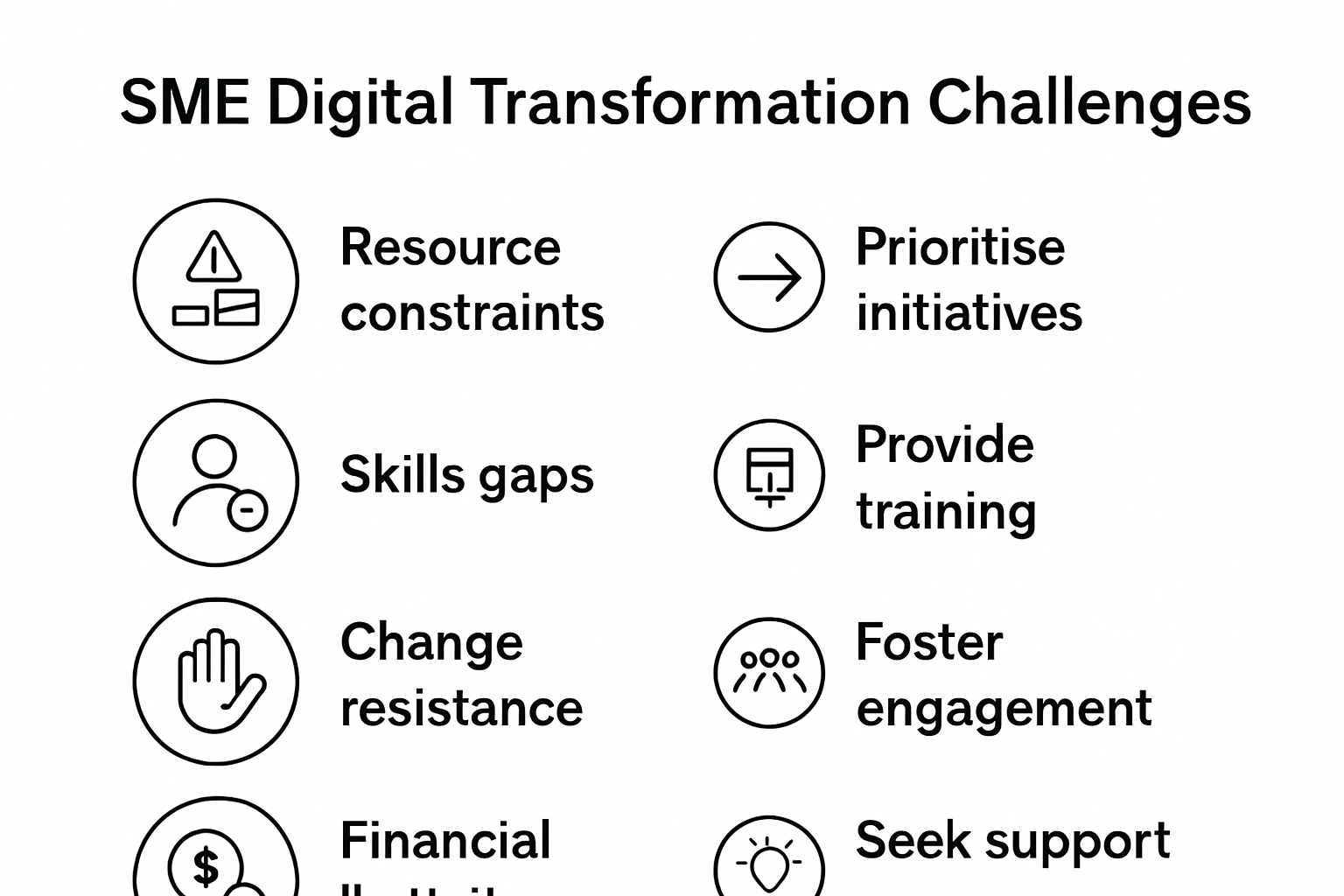Digital transformation sounds like something only big corporates can afford. Yet, research shows that digitally mature small businesses are actually 2.5 times more likely to see revenue growth and improved efficiency than their less tech-savvy competitors. But most surprising of all, the biggest wins for SMEs come not from fancy gadgets or expensive software, but from small, strategic changes anyone can make today.
Table of Contents
- What Digital Transformation Means For Smes
- Key Benefits And Real-World Success Stories
- Simple Steps To Start Your Digital Journey
- Common Challenges And How To Overcome Them
Quick Summary
| Takeaway | Explanation |
|---|---|
| Digital transformation is strategic, not just technological. | SMEs must integrate digital strategies into all business aspects for growth and efficiency. |
| Assess your current digital capabilities. | Conduct a thorough audit of existing systems and skills to identify areas for improvement. |
| Create a strategic digital roadmap. | Define clear objectives and prioritized investments that align with your business goals. |
| Embrace continuous learning and adaptability. | View digital transformation as an ongoing process requiring experimentation and cultural shifts. |
| Overcome resource limitations with training and partnerships. | Upskill employees and seek collaborations to address financial and technological constraints. |
What Digital Transformation Means for SMEs
Digital transformation represents a fundamental reimagining of how small and medium enterprises (SMEs) operate, compete, and deliver value in an increasingly technology-driven business environment. Unlike simple technology upgrades, this process involves a comprehensive strategic approach that fundamentally redesigns business processes, customer experiences, and operational models through innovative digital technologies.
Understanding the Core of Digital Transformation
At its essence, digital transformation for SMEs is about more than just implementing new software or purchasing digital tools. Discover our comprehensive guide on digital strategies that go beyond surface-level technological adoption. The World Economic Forum emphasizes that true transformation requires a holistic approach where digital technologies are deeply integrated into every aspect of business operations.
The OECD reports that digital transformation enables SMEs to overcome traditional limitations by providing unprecedented opportunities for growth, efficiency, and market expansion. This means leveraging technologies like cloud computing, data analytics, artificial intelligence, and automated systems to reimagine business processes, customer interactions, and value creation mechanisms.
Strategic Implications for SME Growth
Digital transformation is not merely a technological upgrade but a strategic imperative for SMEs seeking sustainable competitive advantage. According to research published in the National Center for Biotechnology Information, successful digital transformation fundamentally redefines an organization’s value proposition by enabling:
- Operational Efficiency: Streamlining internal processes through automation and intelligent systems
- Market Responsiveness: Quickly adapting to changing customer needs and market dynamics
- Data-Driven Decision Making: Utilizing advanced analytics to generate actionable insights
For SMEs, this transformation represents an opportunity to level the playing field with larger competitors. By strategically adopting digital technologies, smaller businesses can create more agile, responsive, and innovative operational models that allow them to compete effectively in increasingly digital marketplaces.
The journey of digital transformation is unique for each SME, requiring a careful assessment of current capabilities, strategic goals, and technological opportunities. It demands not just technological investment but a cultural shift towards continuous learning, experimentation, and digital-first thinking. Business leaders must view digital transformation as an ongoing process of adaptation and innovation, rather than a one-time technological implementation.
Ultimately, digital transformation for SMEs is about creating more intelligent, responsive, and customer-centric business models that can thrive in an increasingly complex and rapidly changing global business environment. It represents a critical pathway for small and medium enterprises to not just survive, but to meaningfully grow and compete in the digital age.
Key Benefits and Real-World Success Stories
Digital transformation offers SMEs unprecedented opportunities to revolutionize their business operations, delivering tangible benefits that extend far beyond technological implementation. By strategically embracing digital technologies, small and medium enterprises can unlock significant competitive advantages and drive sustainable growth.
Operational and Strategic Benefits
SMEs implementing digital transformation strategies experience multifaceted improvements across critical business dimensions. Learn more about data-driven marketing strategies that can amplify these advantages.
Research from McKinsey Global Institute reveals that digitally mature SMEs are 2.5 times more likely to achieve revenue growth and operational efficiency compared to their less digitally integrated counterparts. These benefits manifest through:
Here is a summary table highlighting the key operational and strategic benefits SMEs gain from digital transformation, based on the advantages already mentioned in the article. This helps you quickly scan for potential improvement areas in your own business.
| Benefit | How It Helps SMEs |
|---|---|
| Enhanced Productivity | Automation of tasks reduces manual workload |
| Cost Reduction | Streamlined processes minimise operational expenses |
| Improved Customer Experience | Personalised digital interactions increase engagement |
| Operational Efficiency | Automation and intelligent systems optimise internal processes |
| Market Responsiveness | Quickly adapt to customer and market changes |
| Data-Driven Decision Making | Use analytics for actionable business insights |
- Enhanced Productivity: Automation of routine tasks reduces manual workload
- Cost Reduction: Streamlined processes minimize operational expenses
- Improved Customer Experience: Personalized digital interactions increase engagement

Real-World Digital Transformation Success Cases
Consider the remarkable transformation of several SMEs that successfully leveraged digital technologies. According to Harvard Business Review, these case studies demonstrate the profound impact of strategic digital adoption.
A local marketing consultancy transformed its operations by implementing cloud-based project management tools, reducing client communication cycles by 40% and increasing team collaboration. By digitizing their workflow, they eliminated redundant administrative tasks and created a more agile work environment.
Another compelling example involves a small e-commerce retailer who integrated advanced analytics and machine learning algorithms into their inventory management. This digital strategy enabled them to predict consumer trends with 75% accuracy, optimizing stock levels and reducing wastage significantly.
A family-owned restaurant reimagined its business model during the pandemic by developing a comprehensive digital ordering platform. This strategic move not only maintained their revenue during lockdowns but also expanded their customer base by 35%, demonstrating how digital transformation can create resilience and growth opportunities.
These success stories underscore a critical insight: digital transformation is not about adopting technology for its own sake, but about strategically using digital tools to solve specific business challenges and create new value propositions.
The global consulting firm Deloitte emphasizes that successful digital transformation requires more than technological investment. It demands a holistic approach that integrates technological solutions with organizational culture, employee skills, and strategic vision.
For SMEs, this means continuously learning, experimenting, and adapting digital technologies that align with their unique business goals. The most successful digital transformations are those that view technology as an enabler of innovation rather than a standalone solution.
Ultimately, digital transformation represents a powerful pathway for SMEs to not just survive, but to thrive in an increasingly digital and competitive business environment. By embracing digital technologies strategically and holistically, small and medium enterprises can unlock unprecedented opportunities for growth, efficiency, and long-term success.
Simple Steps to Start Your Digital Journey
Beginning a digital transformation journey can seem daunting for small and medium enterprises, but with a structured approach, businesses can navigate this critical transition effectively. Check out our comprehensive guide to digital strategies to help you get started on the right path.
Assessing Your Current Digital Landscape
The first crucial step in digital transformation is understanding your current technological capabilities and business needs. According to the Texas Department of Information Resources, a comprehensive assessment involves evaluating your organization’s digital maturity across multiple dimensions.
Start by conducting an internal audit that examines:
- Existing Technology Infrastructure: Understand current systems and potential integration challenges
- Digital Skills of Your Team: Identify skill gaps and training requirements
- Business Process Efficiency: Analyze areas where digital tools could streamline operations
Digital marketing insights for beginners can provide additional context for this assessment. The University of Maine research highlights that digital literacy is crucial for successful transformation, especially in the wake of rapidly changing business environments.
Developing a Strategic Digital Roadmap
Once you have assessed your current position, the next step is creating a strategic digital roadmap. The U.S. Department of Commerce recommends a methodical approach to digital adoption:
Define Clear Digital Objectives
Identify specific goals your digital transformation should achieve. These might include improving customer engagement, reducing operational costs, or expanding market reach.Prioritize Digital Investments
Not all digital technologies will be equally beneficial. Focus on tools that directly address your business challenges and align with your strategic objectives.Build Digital Capabilities
Invest in training and potentially recruit talent with digital expertise. Creating a culture of continuous learning is essential for successful digital transformation.
Implementation and Continuous Improvement
Digital transformation is not a one-time project but an ongoing journey of adaptation and innovation. Key considerations during implementation include:
- Select user-friendly digital tools that integrate well with existing systems
- Establish metrics to track the performance and impact of digital initiatives
- Maintain robust cybersecurity practices to protect your digital assets
- Create a feedback loop that allows for continuous refinement of your digital strategy
Small businesses should not be intimidated by digital transformation. Start small, be consistent, and remain open to learning and adaptation. Many free and affordable digital tools are available that can help SMEs begin their digital journey without significant upfront investment.
Below is a process table outlining the structured steps SMEs can follow to begin their digital transformation journey, as discussed in the article. This table provides a clear overview to help guide your next actions.
| Step | Key Actions |
|---|---|
| Assess Digital Landscape | Audit existing IT, evaluate team’s digital skills, analyse process efficiency |
| Define Digital Objectives | Set clear goals like improved engagement, cost reduction, or increased reach |
| Prioritise Digital Investments | Focus on technologies that tackle business challenges and support strategic objectives |
| Build Digital Capabilities | Invest in staff training and consider hiring or upskilling for digital expertise |
| Implement & Continuously Improve | Select integrated tools, measure results, maintain security, and refine strategies based on feedback |
Remember that digital transformation is about more than just technology. It is a holistic approach that involves reimagining business processes, empowering employees, and creating more value for customers. By taking a strategic, step-by-step approach, SMEs can successfully navigate their digital transformation and unlock new opportunities for growth and innovation.
Common Challenges and How to Overcome Them
Digital transformation presents numerous challenges for small and medium enterprises (SMEs), requiring strategic approaches to navigate complex technological and organizational obstacles. Explore our insights on marketing challenges to understand the broader context of these digital hurdles.
Resource and Skill Limitations
One of the most significant barriers SMEs face in digital transformation is the constraint of limited resources and digital skills. According to the OECD report on Digital Transformation of SMEs, many small businesses struggle with financial limitations and insufficient technological expertise.
To address these challenges, SMEs can:
- Invest in Training: Develop targeted upskilling programs for existing employees
- Leverage Free Resources: Utilize online learning platforms and open-source digital tools
- Seek Government Support: Explore grants and training programs designed for small businesses
The World Economic Forum suggests that strategic partnerships with technology providers and educational institutions can help bridge the skill gap effectively.
Technological Adoption and Change Management
Resistance to change represents another critical challenge in digital transformation. Many SMEs struggle with cultural barriers and organizational inertia that impede technological adoption. Research from the OECD’s policy recommendations highlights that successful digital transformation requires more than technological implementation.
Key strategies to overcome resistance include:
Create a Compelling Vision
Clearly communicate the benefits of digital transformation to all stakeholdersImplement Gradual Changes
Introduce digital technologies incrementally to reduce overwhelmFoster a Culture of Continuous Learning
Encourage experimentation and view technological challenges as opportunities for growth
Financial and Strategic Considerations
Financial constraints often prevent SMEs from fully embracing digital transformation. The OECD’s report on SME Resilience emphasizes the importance of strategic financial planning and alternative funding mechanisms.
Practical approaches to managing financial challenges include:
- Conduct thorough cost-benefit analyses of digital investments
- Explore cloud-based and subscription-based technology solutions
- Prioritize digital initiatives with clear return on investment
- Consider phased implementation to spread financial burden
Cybersecurity presents another critical challenge. SMEs must prioritize digital security by:
- Implementing robust cybersecurity protocols
- Regularly updating security systems
- Training employees on digital safety practices
- Investing in affordable cybersecurity solutions
The journey of digital transformation is unique for each SME. Success requires a holistic approach that balances technological innovation, strategic planning, and organizational adaptability. By understanding and proactively addressing these common challenges, small businesses can transform potential obstacles into opportunities for growth and innovation.

Remember that digital transformation is not about perfect execution but continuous learning and improvement. SMEs that remain flexible, curious, and committed to their digital journey will be best positioned to thrive in an increasingly digital business environment.
Frequently Asked Questions
What is digital transformation for SMEs?
Digital transformation for SMEs is the strategic integration of digital technologies into all aspects of a business, fundamentally changing operations, enhancing customer experiences, and creating new business models.
Why is digital transformation important for small businesses?
Digital transformation is crucial for small businesses as it boosts growth and efficiency, enabling them to compete effectively with larger companies by streamlining operations and improving customer engagement through data-driven decision-making.
How can SMEs start their digital transformation journey?
SMEs can start by assessing their current digital capabilities, defining clear digital objectives, prioritising investments in digital tools, and fostering a culture of continuous learning and improvement.
What are common challenges SMEs face during digital transformation?
Common challenges include limited resources and skills, resistance to change, and financial constraints. Addressing these typically involves investing in training, seeking support, and implementing gradual changes.
Unlock True Digital Growth With Expert Support
You have just learned how digital transformation can boost growth and efficiency for SMEs, but making the leap alone often feels overwhelming. Gaps in digital strategy, the challenge of integrating technology like Hubspot CRM and automation, and the need for data-driven insights are pain points that cost time and hold your business back.
If you want to thrive, you need more than basic software. You need real-world solutions that fit your goals and budget, plus a trusted partner that turns digital buzzwords into measurable results. That is where the Digital Strategy expertise from Zoo Digital comes in. We help you automate, track, and optimise so you can focus on growth with peace of mind.

Take the first step to real digital transformation. Visit Zoo Digital today or explore our CRM Platform services to see how seamlessly your business can evolve. Do not wait while your competitors move ahead. Let us help you achieve efficient, data-driven results now.
Recommended
- 7 Simple Steps to Digital Transformation for Small Businesses – Zoo Digital
- Top Benefits of Data Driven Marketing for Small Businesses 2025 – Zoo Digital
- Growing Your Online Presence: A Guide for Small Businesses – Zoo Digital
- Digital Marketing Terms Explained for Small Businesses 2025 – Zoo Digital
- Key Digital Transformation Benefits for Business Growth – Solution for Guru
- Digital Transformation in Accounting: How South African SMEs Can Modernize Their Financial Management – Ready Accounting

